I am the happy owner of a weeping cherry tree, and I have grown to love the grace and beauty it adds to my landscape. But these lovely trees might encounter problems just like any other living thing. The health and vitality of weeping cherry trees may be impacted by a number of variables, including environmental factors, diseases, and pests. In this post, we’ll look at some of the most common weeping cherry tree problems and provide workable fixes so you can keep your beloved weeping cherry looking beautiful.
Common problems on Weeping Cherry Trees include sunscald, poor growth, diseases like verticillium wilt and cherry leaf spot, as well as pests such as aphids and spider mites. In order to solve these problems and guarantee the health and beauty of the tree, proper care and maintenance are important. These include shielding the tree from the sun, supplying enough nutrients, pruning, applying fungicides when necessary, and naturally reducing pests.
| Weeping Cherry Tree Problems | Solutions |
|---|---|
| Environmental Conditions | |
| 1. Weeping cherry trees dying may be linked to environmental conditions in the previous year | Evaluate previous year’s weather patterns and potential stressors |
| General Problems | |
| 2. Sunscald: Cracked bark and peeling | Wrap the trunk with a light-colored tree wrap |
| 3. Poor Growth | Fertilize with a 2-1-1 or 3-1-1 ratio of nitrogen, phosphorus & potassium and prune properly |
| Diseases | |
| 4. Verticillium Wilt | Plant trees resistant to wilt and burn dead limbs |
| 5. Cherry Leaf Spot | Apply fungicide when buds emerge and again when leaves are fully expanded |
| Pests | |
| 6. Aphids | Use natural enemies like birds and wasps to control them |
| 7. Spider Mites | Spray with insecticidal soap or horticultural oil |
| Prevention | |
| 8. Planting in the Right Environment | Choose well-drained soil in a sunny location |
| 9. Regular Watering | Water regularly, avoiding both overwatering and underwatering |
Environmental Conditions: The Silent Culprit
It is essential to realize that weeping cherry trees may be delicate about their surroundings. Extreme temperatures, an abundance of wetness, or insufficient sunshine may all have an effect on a person’s general health and vitality due to environmental conditions. Weeping cherry tree conditions are affected by these factors, therefore let’s investigate them.
1. Weeping Cherry Trees Dying: The Link to Previous Environmental Conditions
The health and decline of weeping cherry trees can be influenced by various environmental conditions they experience, particularly in the preceding year. Factors such as droughts, late frosts, and cold winters can have long-lasting effects on the tree’s well-being. Analyzing the weather patterns and environmental circumstances from the previous year is essential to identify probable stressors that may have harmed the tree.
Drought conditions pose significant challenges to weeping cherry trees, as they rely on an adequate and consistent water supply for their growth and survival. Insufficient rainfall and extended dry periods can lead to water stress, hampering the tree’s ability to absorb and retain water. This can result in wilted leaves, stunted growth, and an overall decline in health. Evaluating the precipitation levels and severity of droughts from the previous year can provide valuable insights into the potential impact on the tree’s well-being.
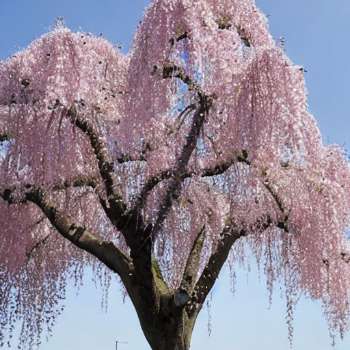
Late frosts represent another potential threat to weeping cherry trees. These frost events occur after the tree has begun developing buds or even during full bloom. Late frosts can damage or kill the tree’s tender new growth, including blossoms, buds, and emerging leaves. Consequently, the tree may experience reduced flowering, delayed growth, or even complete defoliation. Examining the weather records from the previous year, particularly the occurrence of late frosts, can offer a better understanding of the stress the tree may have endured.
Cold winters, especially if they are severe or prolonged, can also impact the health of weeping cherry trees. These trees have specific cold-hardiness requirements, and extremely low temperatures can damage or kill their tissues, including branches and buds. Severe winter conditions can lead to dieback, weakened overall structure, and increased vulnerability to diseases and pests. Reviewing the temperature records and duration of cold spells during the preceding winter can help assess the potential impact on the tree’s health.
Additionally, it is important to consider the overall climatic conditions and long-term environmental factors. Weeping cherry trees have specific climate preferences and are adapted to particular regions and zones. Evaluating the suitability of the climate for these trees can shed light on whether they were subjected to unfavorable conditions that may have contributed to their decline. Factors such as extreme heat, humidity levels, and exposure to strong winds can all influence the tree’s overall health and resilience.
While analyzing weather patterns provides valuable insights, it is crucial to recognize that other factors, such as soil conditions, pest and disease pressures, and management practices, should also be considered when assessing the health of weeping cherry trees. A comprehensive approach that takes into account multiple factors will offer a more accurate understanding of the tree’s decline and guide future planting and care decisions.
General Problems: Nurturing Your Weeping Cherry Tree
You must address common problems that may impede the development of your weeping cherry tree in order to maintain optimal growth and vitality. These problems often result from nutritional deficits or poor maintenance techniques. Let’s look at some of the most common general problems and how to fix them.
2. Sunscald: Cracked Bark and Peeling
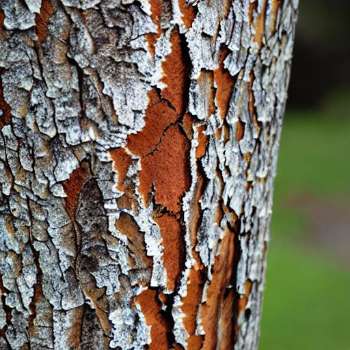
Protecting trees from sunscald is crucial to maintaining their health and preventing damage to their trunks. Sunscald occurs when a tree’s bark on the south or southwest side peels and splits due to excessive sun exposure. The intense heat can cause significant harm to the tree’s trunk. However, there is a simple solution to prevent sunscald in trees, particularly the weeping cherry tree: wrapping the trunk with a light-colored tree wrap.
Using a light-colored tree wrap helps to shield the tree from sunscald by reflecting sunlight. Opting for a light color such as white or light beige prevents the wrap from absorbing excessive heat, reducing the transfer of heat to the trunk. Additionally, the light-colored wrap creates a cooler microclimate around the trunk, offering protection against the direct impact of the sun’s rays.
To apply a tree wrap to a weeping cherry tree, follow these steps. Ensure that the tree is well-watered and in a healthy condition. Begin at the base of the trunk and wrap the tree from the bottom upwards, overlapping the wrap slightly with each rotation. Avoid wrapping the tree too tightly to prevent growth restriction and damage. Leave some space for expansion as the tree grows. Continue wrapping until you reach the lowest branches or the desired height, ensuring that the entire exposed area is covered.
It is important to wrap the trunk during the winter months or early spring when the sun’s rays are less intense. This timing provides adequate protection when the tree is most susceptible to sunscald. Keep the wrap on until warmer weather arrives, typically during late spring or early summer. At that point, carefully remove the wrap to allow the trunk to breathe and prevent any potential issues caused by prolonged wrapping.
Apart from preventing sunscald, a tree wrap offers additional benefits. It acts as a barrier against pests, preventing insects or rodents from burrowing into the tree’s bark. Furthermore, the wrap helps retain moisture by reducing water loss through evaporation, particularly during dry periods.
While using a light-colored tree wrap effectively prevents sunscald, it is crucial to remember that trees require proper care and maintenance throughout the year. Regular watering, appropriate pruning, and providing adequate nutrition are essential for their overall health and vitality. Seeking guidance from a professional arborist or local gardening expert can provide valuable insights specific to your tree species and climate conditions.
3. Poor Growth: Unlocking the Potential
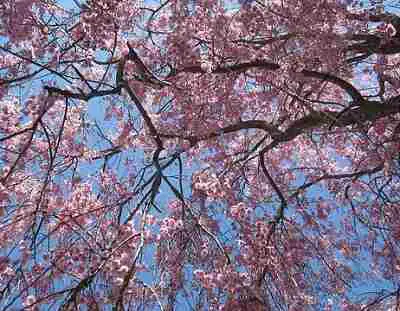
If you notice that your weeping cherry tree is not growing well, it could be due to either a lack of proper fertilization or incorrect pruning practices. In order to address these issues and promote healthy development, it is important to understand the role of fertilization and appropriate pruning techniques.
A common cause of poor growth in trees, including weeping cherry trees, is a deficiency in essential nutrients. Fertilizers are used to provide these necessary nutrients for the overall health and vitality of the tree. To ensure wholesome development, it is recommended to use a balanced fertilizer with a ratio of 2-1-1 or 3-1-1, representing the nitrogen (N), phosphorus (P), and potassium (K) content respectively.
Nitrogen is responsible for stimulating leaf and stem growth, while phosphorus supports root development and flower production. Potassium contributes to overall tree health, including disease resistance and stress tolerance. By applying a balanced fertilizer with the appropriate ratio and following the recommended dosage and timing, you can supply the tree with the necessary nutrients for optimal growth.
Improper pruning practices can also hinder the growth of a weeping cherry tree. Pruning plays a crucial role in maintaining the tree’s structure, enhancing airflow, and removing any dead or overlapping branches. Proper pruning techniques are essential for promoting the tree’s health and encouraging vigorous growth.
To properly prune a weeping cherry tree, begin by removing any dead, diseased, or damaged branches. These branches not only impede growth but can also attract pests and diseases. Next, eliminate any branches that are crossing or rubbing against each other, as they can cause wounds and hinder healthy growth. Make clean cuts just outside the branch collar to avoid leaving stubs or causing unnecessary damage to the tree.
Ensuring proper airflow within the tree’s canopy is vital for robust growth. This can be achieved by thinning out crowded branches and maintaining an open structure. Allowing sunlight and air to reach all parts of the tree facilitates photosynthesis, reduces the risk of disease, and promotes new growth.
It is important to consider the appropriate season for pruning to minimize stress on the tree. Generally, pruning weeping cherry trees is recommended during late winter or early spring, before new growth begins. However, seeking advice from a professional arborist or an experienced gardening expert can provide specific guidance based on your tree’s needs and the climate conditions in your area.
Diseases: Combating Fungal Threats
Numerous fungal diseases that affect weeping cherry trees have the potential to diminish their attractiveness and health. To safeguard your tree, it’s critical to recognize and treat these diseases as soon as possible. Let’s look at two common fungus diseases and how to treat them.
4. Verticillium Wilt: A Severe Fungal Threat
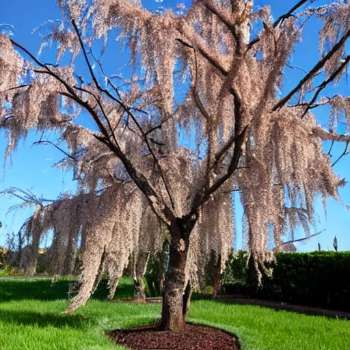
Verticillium wilt is a significant fungal infection that can affect weeping cherry trees, posing a serious threat to their health. This disease spreads through the tree’s vascular system, entering from the roots and causing wilting, yellowing leaves, and, in severe cases, death. Planting wilt-resistant weeping cherry tree varieties is crucial to combat this disease. Furthermore, to prevent the spread of the fungus, it is imperative to promptly remove and properly dispose of any dead limbs that are discovered.
Verticillium wilt is caused by fungi known as Verticillium dahliae and Verticillium albo-atrum, which thrive in the soil. These fungi can survive for extended periods, even without a host plant present. Weeping cherry trees are susceptible to Verticillium wilt, and once infected, the disease progresses rapidly, resulting in severe damage or even the death of the tree.
Choosing wilt-resistant weeping cherry tree varieties is an essential step in preventing Verticillium wilt. When selecting a tree, it is advisable to seek guidance from local nurseries or gardening experts to identify cultivars that have demonstrated resistance to this disease. Wilt-resistant varieties possess genetic traits that enable them to withstand infection and continue thriving in the presence of Verticillium fungi.
In addition to planting resistant cultivars, practicing good sanitation is crucial. Promptly removing any dead limbs or branches from infected trees is essential to prevent the spread of Verticillium wilt. Dead or decaying wood provides an ideal environment for fungal spores to persist, increasing the risk of infection and further contamination. By removing and properly disposing of infected plant material, potential sources of the Verticillium fungi can be eliminated, reducing the likelihood of the disease spreading.
When removing dead limbs, it is important to exercise caution and utilize proper pruning techniques. Sterilizing pruning tools, such as shears or saws, with a disinfectant between each cut helps prevent accidental transmission of the fungus. Carefully cutting the dead limbs at the branch collar, avoiding leaving stubs or causing unnecessary damage to the tree, is recommended. Properly disposing of the infected plant material, such as through burning or sealed bags, further prevents the spread of Verticillium wilt.
Implementing cultural practices that promote tree health and vigor can also aid in managing Verticillium wilt. These practices include providing appropriate irrigation, ensuring adequate soil drainage, and avoiding water stress or overwatering. Well-maintained trees are better equipped to resist diseases and recover from potential infections.
It is important to note that once a tree is infected with Verticillium wilt, there is currently no known cure. However, by implementing preventive measures, managing the disease’s spread, and maintaining overall tree health, the impact of Verticillium wilt can be mitigated, and the health of weeping cherry tree populations can be preserved.
Regular monitoring of weeping cherry trees for symptoms of Verticillium wilt, such as wilting, yellowing leaves, and stunted growth, is crucial. If these symptoms are observed, consulting with a certified arborist or plant pathologist for a professional diagnosis and guidance on the appropriate course of action is recommended. They may advise the removal of infected trees to prevent further spread or suggest measures to minimize the disease’s impact.
5. Cherry Leaf Spot: The Bane of Beautiful Foliage
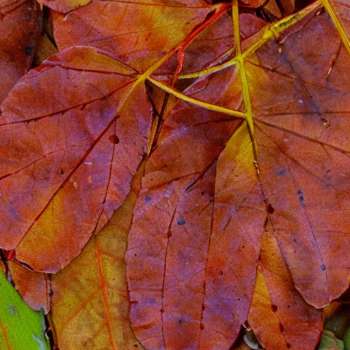
Cherry leaf spot is a fungal infection that can affect weeping cherry trees, leading to the development of purple, yellow, and black spots on the leaves. Over time, these spots have the potential to cause leaf defoliation and discoloration, impacting the tree’s overall appearance. To combat this disease and preserve the weeping cherry tree’s attractive aesthetic, it is important to take proactive measures, such as applying fungicides at specific stages of the tree’s growth cycle.
The fungal infection known as cherry leaf spot is caused by Blumeriella jaapii. It typically presents as small, circular spots on the leaves, initially appearing purple or yellow and eventually turning black as the infection progresses. If left untreated, the disease can lead to leaf defoliation and weaken the overall health of the tree.
To effectively manage cherry leaf spot, timely application of fungicides is crucial. The first application should be made when the buds begin to appear in the spring, prior to full leaf emergence. This early timing allows the fungicide to protect the developing leaves from infection. The second application should occur after the leaves have reached their maximum size, providing continued protection throughout the growing season.
When selecting a fungicide for cherry leaf spot, it is important to choose a product specifically labeled for this purpose. Consulting with local nurseries or certified arborists can help determine the most suitable fungicide for your weeping cherry tree. Follow the manufacturer’s instructions regarding dosage and application methods, ensuring thorough coverage of the foliage to achieve effective control of the fungal infection.
While fungicide application is a significant component in managing cherry leaf spot, it should be complemented by other preventive measures. Implementing good cultural practices and maintaining proper sanitation can help reduce the risk of infection. This includes removing and properly disposing of fallen leaves and debris in the vicinity of the tree. Infected plant material left on the ground can harbor fungal spores and serve as a potential source of reinfection. Additionally, promoting proper tree maintenance, such as ensuring adequate air circulation and sunlight penetration, can help promote leaf dryness and discourage fungal growth.
Implementing appropriate watering techniques is also essential. Avoiding overhead watering and instead focusing on watering at the base of the tree can minimize leaf wetness, reducing the favorable conditions for fungal pathogens to thrive.
Regular monitoring of the tree for signs of cherry leaf spot is crucial. Early detection enables prompt intervention and reduces the likelihood of severe infection. If symptoms such as leaf spots are observed, it is advisable to consult with certified arborists or plant pathologists. They can provide expert guidance on appropriate fungicide applications and preventive measures tailored to your specific situation.
Pests: Defending Against Intruders
The health and aesthetics of a weeping cherry tree may be seriously threatened by pests. These little invaders may harm the branches and leaves, impeding the tree’s ability to expand in its whole. Let’s examine two common pests and their efficient controls.
6. Aphids: Tiny Troublemakers
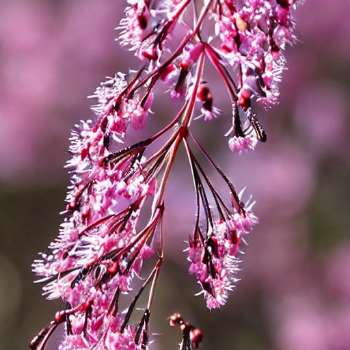
Aphids, small insects, often gather in large colonies on the branches of weeping cherry trees. These pests feed on the tree’s sap, resulting in the secretion of honeydew, a sticky substance that promotes the growth of sooty mold. In addition, aphids can cause branches to twist and deform. Utilizing natural enemies such as birds and wasps is a recommended method to manage aphids. By creating nesting areas and planting nectar-rich blooms, you can attract these beneficial creatures to your yard, helping to control aphid populations naturally.
Aphids are common pests that can cause damage to weeping cherry trees. These tiny insects form dense colonies on the branches and underside of leaves. As they feed on the tree’s sap, they excrete honeydew, a sugary substance that can lead to the growth of sooty mold. Sooty mold appears as a black, powdery coating on the leaves, affecting the tree’s aesthetics and potentially hindering its ability to photosynthesize.
Apart from the unsightly appearance caused by honeydew and sooty mold, aphids can physically damage the tree. Their feeding activities can lead to leaf distortion and curling, as well as the twisting of branches. Severe infestations can weaken the tree and make it more susceptible to other pests and diseases.
While chemical insecticides are available for aphid control, opting for natural enemies presents a safer and more environmentally friendly approach. Birds and wasps are known to be natural predators of aphids, feeding on them as a food source. Attracting these beneficial creatures to your yard can help manage aphid populations without the need for chemical interventions.
Creating nesting areas for birds is an effective way to encourage them to stay in your yard and feed on aphids. Providing birdhouses, nesting boxes, or dense shrubs can serve as inviting habitats. Additionally, incorporating bird feeders with seeds or nectar can offer supplemental food sources, attracting a variety of bird species that prey on aphids.
Another strategy is to cultivate nectar-rich blooms that attract wasps. Wasps are natural predators of aphids and can help control their populations. Planting flowers such as marigolds, yarrow, lavender, and daisies can entice beneficial wasps to visit your garden. These flowers provide nectar and pollen resources that support the adult wasps and their offspring. By diversifying the plant selection and ensuring a continuous bloom throughout the growing season, you can create an environment that attracts and sustains these natural aphid predators.
In addition to attracting natural enemies, there are other cultural practices that can help manage aphids on weeping cherry trees. Regularly inspecting the tree for signs of aphids and their colonies can aid in early detection. If aphids are present, gently spraying the tree with a strong stream of water can dislodge and reduce their numbers. Pruning and removing heavily infested branches can also help control the population. Furthermore, practicing good garden hygiene by removing fallen leaves and debris can eliminate potential overwintering sites for aphids and reduce the risk of recurring infestations.
7. Spider Mites: Sap-Sucking Culprits

Spider mites are a common insect pest that can cause significant damage to weeping cherry trees. These tiny pests extract sap from the leaves, leading to yellowing or browning foliage. To effectively combat spider mites, the use of horticultural oil or insecticidal soap is recommended. These natural remedies not only eradicate spider mites but also ensure the protection of beneficial insects, promoting a healthy and balanced ecosystem in your garden.
Spider mites, belonging to the arachnid family, have the ability to reproduce rapidly under favorable conditions. They are often found on the undersides of leaves, where they feed by puncturing plant cells and extracting sap. This feeding activity can result in the yellowing or browning of leaves, and in severe cases, defoliation may occur, placing additional stress on the weeping cherry tree.
When it comes to controlling spider mites, utilizing natural remedies is a preferable approach. Horticultural oil and insecticidal soap are effective options that are environmentally safe and pose minimal risk to beneficial insects, such as ladybugs or lacewings, which play a crucial role in maintaining pest populations.
Horticultural oil works by suffocating spider mites and their eggs, disrupting their life cycle and preventing further infestation. It is important to choose a horticultural oil specifically formulated for use on ornamental trees and follow the instructions on the product label regarding application rates and timing. Generally, horticultural oil is applied during the dormant season or when temperatures are below 90°F (32°C) to minimize any potential phytotoxicity to the tree.
Insecticidal soap, on the other hand, works by breaking down the protective outer shell of spider mites, leading to their dehydration and eventual demise. It is crucial to select an insecticidal soap approved for use on ornamental trees and follow the instructions for application. Typically, insecticidal soap is applied when spider mite activity is observed, ensuring thorough coverage of the affected leaves and branches.
When applying horticultural oil or insecticidal soap, it is important to target the undersides of leaves, where spider mites are commonly found. Multiple applications may be necessary, following the manufacturer’s recommendations, to achieve effective control and prevent reinfestation.
In addition to using horticultural oil or insecticidal soap, cultural practices can help prevent and manage spider mite infestations. Regularly inspecting the tree for early signs of infestation, such as fine webbing or stippled leaves, allows for prompt intervention. If spider mites are detected, gently spraying the tree with a strong stream of water can help dislodge and reduce their numbers. Providing adequate irrigation and maintaining proper moisture levels in the soil can also discourage spider mite activity.
Promoting beneficial insects that naturally prey on spider mites can be an effective long-term strategy for managing their populations. Planting a diverse array of flowers and herbs that attract ladybugs, lacewings, and predatory mites can create a habitat that supports their presence in your garden. These beneficial insects feed on spider mites and help keep their populations in check without the need for chemical interventions.
Prevention: The Key to a Healthy Weeping Cherry Tree
It is usually preferable to avoid problems than to find a solution. You may reduce the likelihood that your weeping cherry tree will face serious difficulties by taking certain precautionary actions. Let’s look at some crucial advice for keeping a weeping cherry tree in good health.
8. Planting in the Right Environment

To maintain the health of your weeping cherry tree, it is crucial to ensure that it is planted in well-drained soil and positioned in a sunny area. Weeping cherry trees thrive when provided with optimal growing conditions, including proper soil drainage and ample sunlight exposure.
The soil in which the weeping cherry tree is planted plays a vital role in its overall health. Well-drained soil is essential to prevent waterlogging, which can lead to root suffocation and the development of root rot. It is important to choose a planting site with soil that allows excess water to flow freely, promoting healthy root growth and preventing detrimental conditions. If the soil drainage is poor, amending it with organic matter or implementing proper grading techniques can help improve drainage.
In addition to proper soil drainage, sunlight exposure is crucial for the weeping cherry tree’s well-being. Full sunshine is ideal for these trees as it enables them to undergo photosynthesis, the process by which plants convert light energy into chemical energy. Sunlight provides the necessary energy for the tree to produce sugars and other essential nutrients, supporting its growth and development.
When selecting a location to plant your weeping cherry tree, it is important to choose an area that receives abundant sunlight throughout the day. Aim for a location that provides at least six to eight hours of direct sunlight. This level of sunlight exposure ensures that the weeping cherry tree can carry out photosynthesis effectively, resulting in robust growth, abundant foliage, and a stunning display of flowers.
In addition to supporting photosynthesis, sunlight exposure has other benefits for the overall health of the tree. Sunlight acts as a natural disinfectant, inhibiting the growth of certain fungal pathogens and pests. It also stimulates the synthesis of essential plant hormones, which play a role in various physiological processes such as growth, flowering, and fruiting.
However, it is important to be mindful of excessive heat and intense sunlight, especially during prolonged hot periods. In regions with hot summers, excessive heat can be stressful for weeping cherry trees. Providing some shade during the hottest part of the day or using mulch around the base of the tree can help regulate soil temperature and moisture levels, reducing stress on the tree.
While weeping cherry trees thrive in full sunlight, they can tolerate some shade, particularly in regions with intense afternoon sun or in areas where partial shade is caused by nearby structures or other trees. If planting in a shadier location, it is still important to ensure that the tree receives a significant amount of direct sunlight for a substantial portion of the day.
9. Regular Watering: Quenching the Thirst

The health of your weeping cherry tree relies heavily on proper irrigation practices. It is crucial to water the tree regularly, especially during dry seasons, while also being cautious not to overwater, as excessive moisture can lead to root rot and fungal problems. Striking the right balance in irrigation is essential for maintaining the tree’s health and vitality.
Water is an essential resource for weeping cherry trees, providing the necessary hydration for their growth, nutrient absorption, and overall well-being. During periods of low rainfall or drought, it is important to supplement the tree’s water requirements through proper irrigation. This is especially crucial during the establishment phase and for young trees with developing root systems.
When watering your weeping cherry tree, it is important to ensure that the water is distributed evenly and reaches the entire root zone. The root zone extends beyond the canopy’s drip line, so it is important to water a wide area around the tree to encourage the development of a strong and extensive root system.
The frequency of watering depends on various factors, including soil type, weather conditions, and the specific water needs of the tree. As a general guideline, deep watering once or twice a week is recommended. Deep watering allows the water to penetrate the soil deeply, reaching the root zone where the tree can access it efficiently. Shallow and frequent watering, on the other hand, promotes shallow root growth and can make the tree more susceptible to drought stress.
However, it is crucial to avoid overwatering, as excess moisture can lead to problems such as root rot and fungal diseases. Overwatering saturates the soil and deprives the roots of oxygen, creating a waterlogged environment that is conducive to the growth of harmful fungi. Signs of overwatering include wilting, yellowing leaves, and the presence of fungus or mold around the base of the tree.
To determine the appropriate amount of water needed for your weeping cherry tree, it is helpful to monitor soil moisture levels. This can be done by checking the soil’s moisture content using a soil moisture meter or simply by feeling the soil with your finger. Ideally, the soil should be evenly moist but not waterlogged. If the top few inches of soil feel dry, it is an indication that the tree may require watering.
Applying a layer of organic mulch around the base of the tree can help regulate soil moisture and reduce water evaporation. Mulch acts as a protective barrier, preventing rapid moisture loss and keeping the soil consistently moist. It also helps to moderate soil temperature and suppress weed growth. When applying mulch, ensure that it is spread evenly, leaving a gap around the tree trunk to prevent moisture accumulation and potential rot.
In addition to proper watering techniques, it is important to consider the specific needs of your weeping cherry tree. Factors such as soil type, climate, and local weather conditions can influence watering requirements. Observing the overall health of the tree and paying attention to any signs of stress or dehydration can guide your watering schedule.
During periods of extended rainfall, it is important to adjust your watering frequency or suspend irrigation to prevent overhydration. Weeping cherry trees can tolerate temporary periods of dry soil, and overwatering during rainy seasons can lead to waterlogged conditions and potential root problems.
FAQs
How do I know if my weeping cherry tree is dying?
There are a few warning indications that your weeping cherry tree is dying that you should watch out for. Wood that is soft to the touch and disintegrating is one common sign. Place your finger gently against the tree’s trunk or branches. It may indicate rot or illness if the wood feels spongy or crumbles readily. Additionally, if you see a lot of leaf drop, little new growth, or a general deterioration in the tree’s look, it might be a clear sign that your weeping cherry tree is dying. In such circumstances, it is crucial to seek expert counsel or contact an arborist who can assess the tree’s health and provide suitable recommendations.
How do you treat a diseased weeping cherry tree?
To lessen the harm and restore the health of a sick weeping cherry tree, preemptive actions are essential. The first step is to remove any branches and leaves that are obviously infected. Pruning helps stop the spread of illness by removing diseased tissue and enhancing airflow inside the tree. In order to avoid future contamination, be sure to clean your pruning equipment after each cut. It’s also crucial to adhere to the precise treatment guidelines for the illness that is afflicting your weeping cherry tree. Using fungicides or other targeted treatments in accordance with advice from professionals or horticulture specialists may fall under this category. Treatment of a sick weeping cherry tree requires regular observation and immediate response.
Why is my weeping cherry not looking good?
There might be a number of reasons why the weeping cherry tree in your yard is not looking well. Lack of water is one common cause. Regular watering is necessary for weeping cherry trees, particularly during dry spells. Lack of moisture may result in withering leaves, reduced development, and a generally poor look in trees. Make sure the tree is receiving enough water to correct this. Depending on the weather conditions and the soil’s moisture content, deep watering should be done once or twice a week. Be careful not to overwater, too, since this might result in root rot and other problems. Your weeping cherry tree has to be in the perfect balance for it to thrive.
Why are the leaves on my weeping cherry tree wilting?
Wilted leaves on a weeping cherry tree are often an indication of stress or insufficient water. The tree wilts its leaves to preserve moisture when it does not get enough water. This is a survival strategy to reduce excessive water loss via transpiration. Wilting leaves are a sign that the tree needs water, so keep an eye out for them. Make sure the tree’s root zone is receiving enough water to ensure deep penetration into the soil. Watering thoroughly but sparingly and in the proper amounts helps avoid leaf withering and encourage healthy development. However, if wilting continues despite proper watering, it may be a sign of other underlying problems, such illness or root damage, and it is best to seek expert help for a complete assessment.
Conclusion
Weeping cherry trees are a beautiful addition to any landscape because of their flowing limbs and exquisite blossoms. For effective tree care and maintenance, it’s crucial to be aware of the most common problems that these trees may encounter. You can guarantee the health and life of your weeping cherry tree by taking proactive measures and putting the ideas we’ve discussed into practice. Keep in mind that the best way to protect the captivating beauty of these exceptional trees is via prevention and early intervention. So go ahead and take care of your weeping cherry so it will grow and bloom in all its magnificent splendor.
Related Posts:
